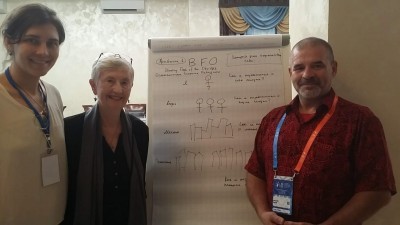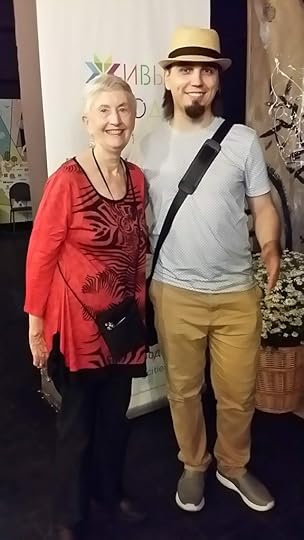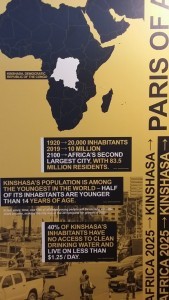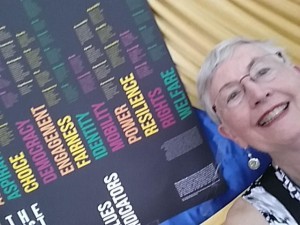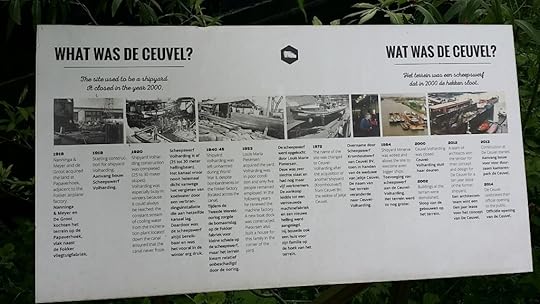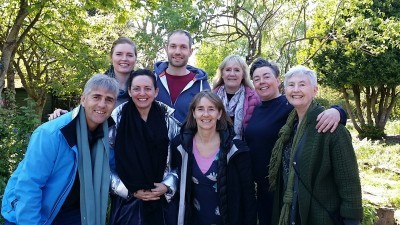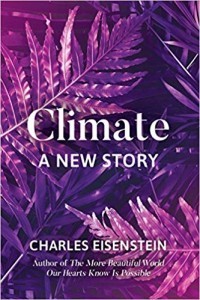Marilyn Hamilton's Blog, page 35
July 9, 2019
City, Psychology and Place Summit Generates Rich Inquiry
The Summit on City Psychology and Place convened by Liverpool University, London Campus and hosted by Charles Landry and Chris Murray attracted an overflow crowd of largely psychologists and psychiatrists.

~
 The themes were large and explored in 2 sections. The morning was opened by Landry’s evocation of Patrick Geddes – that a city is a drama in time. It holds Zones of Encounter and Places of Empathy. A city communicates in every fibre of its being. As a result, it is foolish not to consider the psychology or the emotional intelligence of the city. Landry explored Space, Place and Time (and I was left wondering what role Moral Influence played – the 4th factor I consider when catalyzing leadership?). Landry asked, “In the city where is the Fixed in relationship to the Fluid and the Flexible (and I answered silently, “in the middle of the Meshwork”).
The themes were large and explored in 2 sections. The morning was opened by Landry’s evocation of Patrick Geddes – that a city is a drama in time. It holds Zones of Encounter and Places of Empathy. A city communicates in every fibre of its being. As a result, it is foolish not to consider the psychology or the emotional intelligence of the city. Landry explored Space, Place and Time (and I was left wondering what role Moral Influence played – the 4th factor I consider when catalyzing leadership?). Landry asked, “In the city where is the Fixed in relationship to the Fluid and the Flexible (and I answered silently, “in the middle of the Meshwork”).
Chris Murray brought forward 4 Principles to consider Psychology and the City:
Homo Urbanis
Mind of Village/Body of City
Eco Systems and Ego Systems
Person and Place
He noted that the village arose from groups of 150 to 250 people – possibly the evolution of a number that many brain experts note is the optimum volume of relationships a person can easily manage.
But in the era of villages, time was linear – it followed cycles and seasons. Thus, we are rediscovering in Developmental Psychology, in this information era, time is non-linear and we have need for quiet reflection space – especially in the midst of the Smart City Technology Model. We need to reawaken the Emotional Intelligence of cities.
Murray suggested we need 4 Actions:
To Tap a Reservoir (of intelligence/potential)
To Walk the Walk of the city streets and relationships
To capture the Zeitgeist – the sense of the city that reveals the tipping point of change
To build a Platform from where we can all connect.
Murray invoked the wisdom of James Hillman, that we need to “Improve yourself, [to] Improve the city”.
 We heard next from Prof. Mindy Thompson Fullilove – who takes a bio-psycho-social approach to explore the synergism of place. She explored the experience of African Americans and how the city systems had victimized them through urban renewal policies (during McCarthyism) that wiped out the Left in cities – thus destroying the crux of relatedness that is the great goal of the city (harkening to Jane Jacobs). Fullilove pointed to the city of St. Louis where Google Earth can reveal from space the great divide of gentrification and poverty that separates the city.
We heard next from Prof. Mindy Thompson Fullilove – who takes a bio-psycho-social approach to explore the synergism of place. She explored the experience of African Americans and how the city systems had victimized them through urban renewal policies (during McCarthyism) that wiped out the Left in cities – thus destroying the crux of relatedness that is the great goal of the city (harkening to Jane Jacobs). Fullilove pointed to the city of St. Louis where Google Earth can reveal from space the great divide of gentrification and poverty that separates the city.
On a more positive note, we heard from Jon Rouse about Manchester’s great success in using population health to make policy decisions that are informing the city’s health and social care partnership. Rouse talked of social determinants of health, organic leadership and agile – even messy – bottom-up approaches to improving physical and mental health levels.
On a more casual approach we heard from Aracelli Camago (Centric Lab) about her research into the senses and their influence on the stress response. She appealed to the senses of the city and asked:
How is climate change affecting the living?
Who is the most vulnerable?
How does climate change affect productivity? Who are our lost Einsteins?
Ron Martin of Cambridge addressed Personality and the Economy. He noted that Where you are feeds into your prospects and the success of your economy. He reminded us that Ed Glaser had recommended that “place-based policies must add people-based policies”.
Prof. Rhianna Corcoran of Liverpool U reiterated that we can now track epigenetics in cities. The quality of place has a real evolutionary impact. We must overcome our “place-blindedness” and recognize that qualitative analysis can expand and affirm the quantitative research on risks and threats, niceness and trust. (And moreover, there does not appear to be evidence of outcomes from top-down efforts to change our places/cities.)
After lunching, our discussion switched to Vital Spaces and Calm Space and we started to look for the ramps for (improving) mental health.
We considered sonic models for creating calming spaces; the role of creative design and expression.
Finally, we heard from Sue Jarvis of Liverpool U, with a perspective of Social Psychology – and its contribution to health and wellbeing in the city.
This Summit on City, Psychology and Place was a full day that asked many questions and opened many doors for further exploration. WE were reminded that our need for therapeutic communities had to be matched with our need that for communities that were therapeutic.
Integral City was left with some questions of its own:
How can one bridge the gaps in the city without considering evolutionary and developmental psychology?
What role do organizations/workplaces play in impacting mental health?
How can you consider the wellbeing of the city without embracing all four quadrants of bio-psycho-cultural-social realities?
What are the differences in Points of View that different generations and different cultures bring to city wellbeing and communities that are therapeutic?
July 8, 2019
Living Cities Russia Discovers “Habits for Changing Cities”
On June 20 Integral City revisited Moscow to celebrate 5 years since we launched the Russian Translation of Integral City: Evolutionary Intelligences for the Human Hive.

Eugene Pustoshkin, my brilliant and perceptive translator met me at the theatre (where Stanislavsky developed his Method Acting) and later I had the pleasure of spending some time with Dmitri Baranov of iPratik my Russian Publisher. We were greeted by Lev Gordon co-founder of Living Cities Russia Forum (the successor to ARGO – Izhevsk’s City Development Association).
The Forum had prepared for my arrival with an Interview (published as Instalment 1 here and Instalment 2 here). They were also active in living out the Principles of Integral City – recently republished as “Imagine Your City as a Thriving Innovation Eco-System” – also translated into Russian for the benefit of social entrepreneurs and city activists alike.
At the Civic Chamber Moscow, Integral City (Marilyn Hamilton) delivered a workshop on Caring, Contexting and Capacity Building for Gaia’s Living Cities. Our key message connected to the Integral City Master Code which the Living Cities Association very strongly rests on.
The next day, we participated and witnessed an interesting experiment in Self-Organization – where the facilitator held the space for 20 people to discover their relationships, intentions and commitments to change. The group identified themselves as the Group for Committing to Habits for Changing Cities.
I had been blessed with great translators (most of whom now had the experience of travelling the world and so brought back to Russia international experiences and worldviews). As a result, I had been able to follow the ebbs and flows of lively discussion throughout the day and was able to stand up at the end and point out that the meta-habit for change could be articulated as the Integral City Master Code for Change.
I confessed to everyone, that at the end of every day I practice the habit to review how have I lived the Master Code for Change?
How have I cared for myself?
How have I cared for others?
How have I cared for place(s)?
How have cared for the planet?
We were all delighted that the full circle of self-organizing dialogue could once again land solidly on the universal Master Code of Care.
~
Meanwhile down the hall a second group was convened to explore the relationships in villages and rural habitats. I was once again reassured that the core principles of Integral City were alive and well. The facilitator had chosen the 3 Questions with which Integral City research typically begins:
What works well around here?
What does not work so well?
What do you imagine/hope for the future?
In small groups the gathering of about 40 people found the values and needs that revealed their strengths and potentials.
~
At an alternative site, I saw a different side of Moscow, – a kind of time warp – nestled in an older residential area. There an old industrial site “Shagi” , being rehabilitated as a social enterprise was proudly toured by the new owners. We heard that already this “third place” had a restaurant providing delicious traditional foods, and housed the thriving business of antique selling (with a timeless collection of clocks), a whole floor devoted to antique coin exchange and in the bowels of the building where we engaged – the facilities for workshops, musical gigs, awards ceremonies and designing videos to share the story of Living Cities.)
On the last day, I toured the magnificent living galleries of the Moscow Metro – and (proudly) found my own way back to the airport on the express train.
Moscow is a surprising city showing off the food and vehicles of “cowboy capitalists” while striving to create the conditions for a new generation to thrive and innovate. No small thanks are due to innovators and pioneers of a new consciousness like Lev Gordon and Eugene Pustoshkin.
Integral City in Amsterdam: WeMakethe.City Better for All of Us
In 2019 the WeMakethe.City Festival in Amsterdam featured the theme “Better for All of Us”. It is a week-long festival that expanded out from the city centre to include the wider metropolis of Amsterdam this year. The number of events enables the 4 Voices of the City to attend from morning to night exploring a plethora of topics – embracing Metropolitan and Urban Conferences, Talks, Expos, Specials, Movies, Expeditions and gatherings.
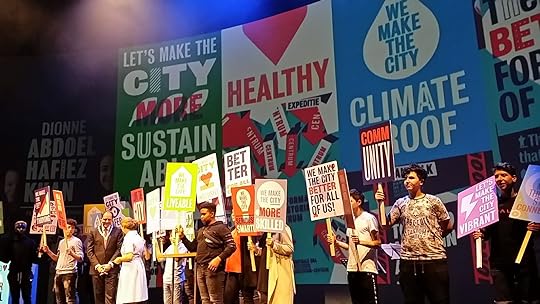
Opening night was an extravaganza of staging at Amsterdam Theatre – featuring music, interviews, multiple generations and lively moderation. Every contribution was tagged with a memorable quotation and we left inspired to see the rest of the week’s events.
~
One of the Festivals’ most provocative multi-media displays was set out on the first floor of the Amsterdam Public Library. There an exhibition of Future Cities surprised me with – not futuristic urban landscapes – but with cities in the developing world seizing new opportunities driven by the imagination and activation of many millennials.
Kinshasa featured itself as the new fashion Paris of Africa.
 South America featured Medellin IT and Lima’s prowess in food and restaurants.
South America featured Medellin IT and Lima’s prowess in food and restaurants.
Addis Ababa sounded a clarion call for its music scene.
The Yangon display was still being mounted as I walked through.
~
Integral City participated in 2 other events – one took us to the south-east of the city to De K-Buurt – a community – there we met a local team organizing a community gathering to plan for a Community Master Plan. The K-Buurt faces the challenges of old apartment blocks fighting poverty, literacy and economic deprivation. Residents want to discover new purpose and intend to create an inclusive, livable neighbourhood.
This half-day afternoon event was organized around Toni Griffin’s The Just City Index – a set of Social Justice Values (presented at 2018 WMTC festival). Experts from cities around the world gave us short energizers on each value and then moved us to break-out tables. There we joined lively discussions anchored around 2 of the values and explored with the experts, community representatives and visitors (like me) how those values could show up in the Master Plan.
I sat at a table focused on Connecting and Unexpected Emergence – hosted by an Amsterdam facilitator and with visitors from Milan, USA, and community members originally from Ukraine and Azerbaijan.
At the end of the afternoon we had energizing reports from 10 tables with ideas linked to all the Just City Values and commitments to take the next steps.
~
The second event Integral City enjoyed was the delivery of our Green Sustainability Manifesto. We joined Oleg Lega and his team to visit DeCeuvel – a waterside neighbourhood in North Amsterdam committed to incubating social enterprises. It was a perfect location for us to deliver our messages of personal, organizational and urban change.
On the wall of our meeting room 3 posters were displayed, illustrating the material flows of the globe, DeCeuvel and a Dutch citizen.
Our small but attentive audience cheered on and joined our commitment to personal and organizational change that makes urban change possible.
You can read the manifestos here:
New Sincerity Manifesto
Green Sustainability Manifesto
4 Voices of City Visit Amsterdam, Moscow, London
Summer has become the season of city festivals, fora and conferences and in the last month Integral City has met the 4 Voices of the City attending a Festival, a Forum, and a Summit.

In the mid-June Integral City returned to the WeMakethe.City Festival 2019 in Amsterdam. We gave a workshop in 2018 on the 4 Voices of the City.
This year we participated in a neighbourhood plan-to-plan a Community Master Plan.
We also declared our Green Manifesto in tandem with the New Sincerity Manifesto.
In the third week of June we travelled to Moscow for the 5 Year Anniversary of Urbanfest – which has transformed into Living Cities Russia Forum.
In Moscow we delivered a workshop on Care, Contexting and Capacity Building.
To finish June, we accepted an invitation from Charles Landry and Chris Murray to attend their first City, Psychology and Place Summit.
Read all about our impressions, experiences and outcomes in the following blogs.
June 15, 2019
Integral City Reflective Organ – June Solstice 2019: 4 Voices Imagine the Human Hive

This newsletter is published quarterly using a cycle of perspectives on the Integral City viewed from: Planet, People, Place and Power. The theme of this issue is People.
For tens of thousands of years (or possibly hundreds of thousands of years) humans were contained in local contexts that became the objects of care that sustained and taught people what and how it was possible to live. As both caring and capacity dimensions expanded within local contexts, those boundaries expanded and the boundaries of the local were traversed into the watersheds, the regional, the continental, the oceanic, the global and as we have now explored, into the Earth-orbital and solar systems—with the ambassadors of our satellites pushing out into galactic and intergalactic spheres.
Hamilton, M. (2018) Integral City 3.7: Reframiing Complex Challenges for Gaia’s Human Hives. Minneapolis, MN: Amaranth Press, p. xxx
Scroll to end of newsletter to access Free Resources.
 Imagine the Human Hive
Imagine the Human HiveImagine the city as a human hive – a living organ of Gaia who has a purpose that is in service to Gaia’s wellbeing and sustainability and is embraced by its citizens.
Imagine human hives who can resource their purpose with internal and external resources and funding.
Imagine the human hive as a living innovation eco-system, where we enable the connections between the 4 voices of the city – Citizens, 3rdSector/Civil Society, City/Institutional Managers, Business/Innovators – so they not only thrive today but create a legacy of life conditions for the next generations to evolve and thrive.
Imagine human hives who know how to connect. They can map their existing connections, align people to purpose and priorities. They can amplify what works, let go of what doesn’t and continuously improve the value they contribute to Gaia.
Imagine human hives who learn from each other and develop the whole system of human hives in an evolutionary direction.
If we can imagine such a city, we can imagine creating and implementing plans for the glocal-scale challenges of climate adaptation, energy shifts, water management, food security and cultural evolution. To do so, we can imagine how to release resources now trapped in city sectors, silos and stovepipes. We can imagine the frameworks, tools and processes that catalyze new conversations, build on the underlying values and recalibrate the assets, capacities and capitals into meshworks of economic, environmental, social and cultural interests. We can imagine creating the model for community engagement, city development, business strategies and communication technologies to evolve the intelligences in our cities into thriving human hives.
Signs of Human Hives Emerging in 2019 and Beyond
When I imagine the city as the Human Hive – with the 4 Voices acting, behaving, relating and co-creating our evolutionary future, I imagine that by working together we can backcast from that powerful vision of the future. I remember the research I have done to identify 12 intelligences that a city as a complex adaptive, living system would have to manifest through the lives of our 4 Voices, if it wishes to resiliently survive and evolve.
From this future forward projection we can plan out what would need to be done to achieve it – strategic designers call this backcasting. [We have mapped out 17 steps in this blog.]
Now that we are at the mid-point of 2019 we can consider what impacts our current life conditions will have on our attempts not just to imagine ourselves as a human hive but to become one. We can ask ourselves, “What needs to happen in 2019 for our next steps as a human hive to emerge?”
I propose we need to start with Intelligence 1: Eco-Intelligence.
We need to thread that through the Mastercode and see how that will change our individual behavior, relationship with others, respect for our ecology and align our human ethos with the whole of life on Mother Earth.
In 2019 we have seen extensions of #metoo from individual experience/blame of one gender to other genders. Is it too soon to hope that this process is starting to catalyze the evolution of respect for all humans? For mutual trust and respect (MTR) provides the foundation for healthy human living systems.
As MTR deepens, we catalyze the deepening of care for our families to another level of appreciation. This is also fundamental to enable the manifestation of what our children – who are joining Greta Thunberg – can expect as their legacy through changes to our own behaviours, especially related to respecting the ecology of living systems that populate Earth.
Through the gateway of respect we can continue the journeys to understanding our fractal relationship to Energy (already started), Information (IT underway) and Matter – in the form of actions/systems/infrastructrues and the relationship to the Intelligences of Nature.
Cosmic Holograms may well become the new math for our children. The Blue Planet should become the basis of our new morals and relationship to all life. Ecocide should be a very real (and international) crime that entails consequences, restitution and regeneration. The Plastic Revolution/ Extinction Revolution is already igniting Citizen Voices in countries around the world, demanding that Business/Innovator Diversity Generators take responsibility for their cleanup. Moreover our Civic Manager Resource Allocators are being called to wake up to their real job of creating the conditions for wellbeing by holding all 4 Voices accountable and transparent to individual human hives and their eco-regions.
It is time now for the 3rd Sector/Civil Society as Integrators of the Hive Mind to claim their voice of integration and demand that Spirit be welcomed back as a guiding force for life enhancing decision processes that impact everyone in the human hive.
2019 is forcing us to look to the End of Slavery and the End of Ecocide– to see the patterns of decisions, actions, legislation, etc. that we must initiate in 2019 so that all our (climate and environmental) targets for 2020, 2030 and beyond can be met.
Is it possible that in 2019 we will even start to unlearn the ancient power of shaming and heal it with LOVE to transform the millennials and their children into a force for good?
Integral City (inspired by Elisabet Sahtouris) has imagined the full backcast of 17 steps that are needed for our human hives to become innovation eco-systems. You can read the full set here.
Congrats to Integral City Beyond Smart and Beyond Resilient 2019 Grads
We are pleased to congratulate the Grads from our Beyond Smart and Beyond Resilient 2019 Training programs. Pictured: Govert Van Ginkel, Tessa Brock, Maria Prieto, Edward Fitsell, Tylara Duncan, Caroline Theiland with co-focalisers Beth Sanders, Marilyn Hamilton, (missing Julian Baller).
Integral City Book 3
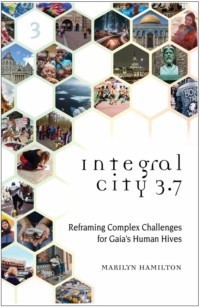
Integral City 3.7: Reframing Complex Challenges for Gaia’s Human Hive is the third book in our Integral City series (hence the “3” in the new title). Like Books 1 and 2 it is dedicated to the 7th generation from now – the context for decisions that many indigenous people consider – hence the “7” in the title. Book 3 considers a series of apparently intractable challenges that all cities face because the world has become so complex that cause and effect are rarely directly linked. The exploration links to three themes that are eternal practices for designing a collective life that works for all life; namely, Caring, Contexting and Capacity Building. Send us an email if you would like a copy to review.
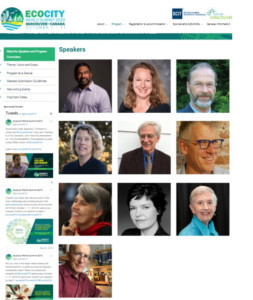 Upcoming Integral City & Constellation Events with People Purpose
Upcoming Integral City & Constellation Events with People PurposeJune 19, 2019 Integral City will be dancing with Manifesto energies of Wemakethe.city 2019 Festival at DeCeuvel in Amsterdam.
June 20, 2019 we will travel to Moscow for the fifth anniversary of Living Cities’ Urbanfest.
June 27, 2019 we are invited to participate in London in the first Urban Psychology Summit with Charles Landry et al.
July 11-13 we will visit Plovdiv Bulgaria to bring the Voice of the City to the Co-Creating Europe Forum
July 14-17 we will participate in a lively inquiry with the Global Ecovillage Network European Conference in Tuscany Italy.
September 5 will see us in London to give the lecture at the Good Governance Institute exploring Good Governance “Because it is Personal”
September 14-17 Integral City training “Beyond Complexity” in partnership with Findhorn College
October 7-11 will see us in Vancouver Canada for the 10th Ecocity World Summit to deliver a plenary and two workshops
October 19 all things being equal we will return via Copenhagen to attend the C40 Climate Summit
November 5 presents the opportunity to take Integral City to Delhi, India to dialogue with the Applied Behavioral Psychology Conference
Life-Giving Words of Wisdom for a Living Planet
Charles Eisenstein, author of Climate a New Story makes a very persuasive case for a living systems agenda to reframe the whole story of Climate Change. He argues that the carbon emissions strategy is a distraction from the real culprits of soil desecration and ignorance of the primacy of the water cycle to the Earth’s living system. He proposes that regeneration of both soil and water even trump our obsession with energy and development. “If you knew she could feel, you would stop,” is the challenge Eisenstein gives to climate change deniers and warriors. Reminding us of the respect of the Indigenuous peoples for the bio-sphere, Eisenstein offers practical strategies for those genuinely desiring to Wake Up Humans and their Hives.
Polly Higgins, author of Eradicating Ecocide: Laws and Governance to Stop the Destruction of the Planet died on the way to making ecocide a crime, able to be tried and punished in the International Court of Justice in the Hague. She imagined an International Court for the Environment “to be led by retired judges, climate change experts and public figures … who could protect and enforce “the right to a healthy environment”. P. 157. Polly quotes the inspiration from William Wilberforce who vowed “that slavery was so dreadful and so irremediable that I resolved I would not rest until I had effected its abolition”. P.171
Regrettably Polly did give her life for what she so strongly believed in – we can honor her spirt by becoming Earth Protectors, willing to carry on the movement she birthed.
Thomas Friedman, author of Thank You for Being Late: An Optimists Guide to Thriving in the Age of Accelerations tackles the challenges created by the “Age of Accelerations”. Through the lenses of technology, globalization and living systems, Friedman offers an excellent road map for what has happened since the turn of the 21st century. He settles on 3 “M’s” – Moore’s Law, Market, Mother Earth – as the factors contributing to the perennial time squeeze that generates so much stress that it is shifting the capacities of the 4 Voices to share worldviews, values and resources. Engaging with each of the M’s is creating haves and have-nots and in the process damaging Earth seemingly beyond repair. Friedman doesn’t believe the accelerations will slow down but he does call readers to take responsibility for regenerating the damage to Mother Earth and to relate to one another in community – effectively to engage the 4 Voices in service to the Master Code of Care- as his optimistic expectation that America (and other nations) can be great again. (p. 512)
Ann Dale, author of Edging Forward, Achieving Sustainable Community Development explores the power of stories to change the way we respond to climate change, by changing the way we relate to one another. Using favourite titles, themes and characters from Dale’s childhood stories, she re-stories herself and in the process reveals deeply embedded archetypes that explain why we take the “rabbit hole” to unsustainable outcomes as well as where we have the capacity to bridge barriers to tackling the bio-diversity imperative. A master of strategic analysis of all the key sectors in the human hive, Dale identifies 3 social imperatives – climate change adaptation and mitigation, biodiversity conservation and sustainable community development. (p. 86). She shares an impressive list of examples of the Canadian communities who have made a difference in all 3 challenges – from energy to transportation to environmental restoration.
Celebrating People in the Planet-of-Cities in the Coming Quarter of 2019
June 21 marks the start of what Integral City calls the People Quarter (from June 21 to September 20). Who is demonstrating leadership in your city? How are you working with the 4 Voices? What changes that you would like to see in your city would you start by living yourself? Visit us on the our Integral City Website and Blog or post a comment about mentors, coaches and facilitators who are bringing together resources that connect on our Facebook page.
Marilyn Hamilton and the Integral City Constellation Corps Team
PS Here are some FREE resources for nurturing our Planet and the Human Hive:
Integral City Consciousness at Climate Change Conference
Comparing Integral City Intelligences with Charles Eisenstein Living Earth
Manifesto for Integral City Climate Change Agenda for Organizations
Interview for Living Cities – Part 1Interview for Living Cities – Part 2
Imagine Your City as a Thriving Innovation Ecosystem
Newsletters Past Issues 2019-18
Integral City Reflective Organ – March 2019: Are Cities Evolving as Gaia’s Reflective Organs?
Integral City MetaBlog 2018 – A synthesis and index of all Integral City Blogs from 2018.
Integral Cities of the Year 2018 – 6 AIKA – for the collaborative city spirit amongst 6 cities in Finland.
Meshworker of the Year Award 2018 – Diana Claire Douglas for Systemic Constellation Work for the Collective.
Integral City Reflective Organ – December Solstice 2018: Reframing Complex Challenges with the Power to Change
Imagine Your City as a Thriving Innovation Ecosystem
For us to imagine the Human Hive as a thriving innovation eco-system we can learn both from the wisdom of evolution biologist, Elisabet Sahtouris and the three principles used to frame life/work/relationship intentions at Findhorn The Park. We have adapted the conditions that Elisabet sets out into 17 steps divided into Findhorn’s precepts of Deep Inner Listening, Work as Love in Action and Co-Creating with the Intelligences of Nature.
These are the steps that the 4 Voices of the Human Hive can use to implement the 12 Intelligences and live the Master Code of Care for Self, Others, Place and Planet.

DEEP INNER LISTENING
Imagine Your City has a sense of its own Spirit and discovers its purpose in service to the wellbeing of its eco-region and the planet.
Imagine that Your City valued its values, history, traditions and culture so that it conserves what works well and teaches it (or shares) with others, including children, youth, seniors, business, civil society, and city hall.
Imagine that Your City was open to creative change so that it could replace what does not work well with what can work better, and even inspire people to want more change.
Imagine that Your City discovers the wisdom and resources to create itself as a valued and valuable city – for its citizens, families, organizations, communities, neighborhoods, sectors, state and country.
WORK AS LOVE IN ACTION
Imagine that Your City appreciates the great diversity in the city – from workers who produce value, to innovators and artists who generate diversity, to investors and resource allocators who find and manage resources for worthy projects, to integrators who see the city as alive for humans as a beehive is for bees.
Imagine that Your City has an innovation eco-system that provides it with a thriving economy that draws on its history of success in manufacturing and co-creates new opportunities through innovation laboratories at its universities and businesses.
Imagine that Your City’s education and training sector in conjunction with business and civil society, committed to the high school graduation as a minimum target for its children; coop and intern opportunities for youth; and with governments, created the conditions for full employment for all adults.
Imagine that all students in Your City learn in school: mutual trust and respect; how to dialogue with others; how to cooperate through teamwork with others; and how to coordinate projects and processes to produce life-giving results.
Imagine that Your City commits to balancing interests for a healthy economy and wellbeing amongst its citizens through engaging with all the voices of the city in making decisions, managing plans and achieving goals.
CO-CREATING WITH INTELLIGENCES OF NATURE
Imagine that Your City has an integrated sustainability plan so that it measures, tracks and exchanges sustainability data related to energy, water, food, finance, economic production and climate, that it shares internally with city stakeholders and externally with other cities in the region.
Imagine that Your City understands how it adds value to the economy and environment and positions itself strategically in relation to other cities in the region, the eco-region, Your Nation and the Planet.
Imagine that Your City has excellent information systems that inform the decisions of not only city hall, but all businesses, citizens, civil society, institutions (healthcare, education, spiritual), eco-regions and all government levels (state, regional, national).
Imagine that the management of Your City meshworks so well by integrating stakeholders that it is a model for other cities of its size in Your Eco-Region, Your Nation, Your Continent and the world.
Imagine that Your City’s ability to respond to stresses (environmental, economic, physical, cultural, social, psychological) at all levels of scale, creates a resilient city, because all stakeholders working together (in a meshwork) create the conditions for everyone in the city to communicate with each other willingly and regularly.
Imagine that Your City is fully optically/energetically/IT wired so that all parts of the city could communicate internally and externally with the rest of the world.
Imagine that Your City practices transparent governance, accountability and accessibility to information so that people feel safe to share, care and relate to each other, their places and the planet fairly.
Imagine that Your City balances efficient management with enough extra resources that the city is resilient to change co-creating with the intelligence of Nature.
June 12, 2019
Interview for Living Cities – Part 2
This 2-Part Interview with Marilyn Hamilton, Founder of Integral City, was shared with Living Cities Russia as they prepare for their fifth Living Cities Forum in Moscow June 21-23, 2019. This is Part 2.

LC3/ Trust, cooperation and communications are the core principles in any development, of a city, community or a company. How does the Integral City paradigm embrace the principles? What we could actually learn from the beehive ecosystem to build trust, quality communications and cooperation in our cities?
Trust, cooperation and communications are fundamental to the Integral City – they are what contributes to what I call the Master Code of Care – Care for Self/Others/Place/Planet. We must care for ourselves, so that we can communicate care (and cooperate with others), so that together we can care for our places (cities, communities, workplaces, homes) and altogether we can care for our planet.
The beehive demonstrates how this works as a complex adaptive system where the bees are trained through a progression of gradually more responsible jobs, first caring for the young brood, then each other, then the queen and finally being trusted to forage for nectar and pollen (their renewable energy) at progressively greater distances from the hive.
The beehives have also developed 4 roles in the hive that inspired the 4 Voices of the “human hive”. In the beehive the Citizens are the “Forager/Producers” who collect the energy supplies; the Business/Innovators are called “Diversity Generators” who constantly locate new resources for the Foragers to collect; the Civic Managers in the hive are called “Resource Allocators” and together with the “Integrators” (who are their “Civil Society”) they determine if the hive is attaining its superordinate goal – which is to produce 20 kg of honey per year. The beehive shows us how their sustainability depends on having a “life-giving” goal, intentional roles and communicating constantly about their performance and productivity. But in addition as they sustain the hive, bees pollinate their eco-region – thereby ensuring that renewable energy supplies will be for the hive next year. (And all the other life systems that depend on this pollination also benefit from the bees’ solution for sustainability and resilience.)
The beehive is the inspiration for an Integral City as a “human hive” – not only to be able to sustain itself but to gain resilience by being of service to its eco-region so that it can cultivate and regenerate a circular economy that is interdependent with the city’s life systems – all of which depends on deep trust, cooperation and communication.
LC4/ How would you describe a living and happy city?
A living and happy city is one that has energized the 4 Voices of the City – Citizens, Civic Managers, Business/Innovators, and Civil Society/3rd Sector – to discover and serve the city for a purpose that serves Gaia’s wellbeing. In this way they live the Master Code of Care for Self/Others/Place/Planet and generate a natural circular economy that replenishes and regenerates the eco-region of the city.
I believe that Deep Happiness arises when we make all our decisions at all scales in a way that fulfills the Master Code of Care. It is an algorithm that expands value exponentially as each level of Care is implemented.
Deep Happiness arises through the multiplication of these factors – Care for Self x Care for Others x Care for Place x Care for Planet.
Social Media:
LI: Marilyn Hamilton https://www.linkedin.com/in/marilyn-hamilton-629494/
FB: Integralcity Meshworks Inc https://www.facebook.com/IntegralCityMeshworksInc/
TW: integralcity https://twitter.com/integralcity
Website: www.integalcity.com
Training:
Beyond Smart https://www.findhorncollege.org/course/beyond-smart/
Beyond Resilient https://www.findhorncollege.org/course/beyond-resilient/
Beyond Complexity https://www.findhorncollege.org/course/beyond-complexity/
This is Part 2 of a 2 Part blog. Click here for Part 1
June 8, 2019
Interview for Living Cities – Part 1
This 2-Part Interview with Marilyn Hamilton, Founder of Integral City, was shared with Living Cities Russia as they prepare for their fifth Living Cities Forum in Moscow June 21-23, 2019.

LC1/ Marilyn, you founded the Integral City Meshworks Inc., which now has become a global constellation. What does it mean for you to realize that the Integral city paradigm works globally now?
The Integral City paradigm is being demonstrated as a framework for cities that integrates all the other city frameworks. It does not say other frameworks are wrong or not useful – rather the Integral City paradigm transcends and includes Happy Cities, Smart Cites, Resilient Cites, C40 Cities, etc. The name for Integral City in Russia – Living Cities – is a beautiful acknowledgement of what Integral City integrates; namely, that cities are complex adaptive living systems; they are developmental and evolutionary human systems; they bring together consciousness and culture as well as technology and infrastructure; they are so complex they need to be understood through all their diversity, plurality and dynamics of change. Integral City Meshworks creates the conditions for both Placecaring (through consciousness and culture) as well as Placemaking – which is what most of the other frameworks focus on (through technology and environment). We say the training for Integral City (which we deliver in partnership with Findhorn College) goes “Beyond Smart, Beyond Resilient and even Beyond Complexity”. So seeing the 5 maps of Integral City being used by practitioners not only in Russia, but Australia, Finland, Netherlands, Germany, Spain, France, UK, South Africa, Canada, USA, and Mexico is a real joy and inspiration. It seems that our approach of attracting and training practitioners, catalysts and meshworkers who are ready to do this work, means we have created seed beds able to nurture and incubate this new paradigm in many key locations around the globe. We could even dare to say they are becoming early stages for Gaia’s Reflective Organs (a term coined by James Lovelock, author of Gaia Hypothesis).
LC2/ This year Living cities forum’s manifesto is «To know. To be able to do. To act». As an “AQtivator”, what advice would you give to newcomers in city development, leaders and initiators of urban projects on how to move from “what I know and can do” to real actions?
In order to move from “ what I know and can do ” to real actions, my first advice would be to “find the energy for change” with others – move from the “I” to the “we”. The Integral City work or paradigm depends on one or more of the “4 Voices” of the city – Citizens, Civic Managers, Business/Innovators, and Civil Society/3rd Sector – initiating an interest in or a call for action to change. The next step is for the initiators to invite all four Voices to inquire:
What is the change we want (change from what to what)? What is our superordinate goal that we wish to attain?
So What – why is this important to us? What values and vision underlie our desire for change?
Now What – What are the next natural steps to move towards the change we want? What are our goals and objectives and who (individuals, organizations, associations) will take responsibility for them? How will who do what, when, for what purpose?
This approach combines the methodologies of Action Research/Inquiry and Meshworking – bringing together both self-organizing and structuring capacities to attain the superordinate goal.
As an “AQtivator” I would help city Voices to appreciate, map and catalyze:
all quadrants (Voices)
all levels of complexity and capacity that have evolved in the city
all lines of intelligence (we count 12 for an Integral City)
all types of diversities
in service to a purpose that serves Gaia’s wellbeing
Read the second part of this Interview here.
Manifesto for Integral City Climate Change Agenda for Organizations
This article by Marilyn Hamilton is republished here with permission from Enlivening Edge – where the original was published June 7, 2019. See below for link to full article.
On the way to co-creating an Integral City—one that is TEAL/YELLOW in its design, operation and regeneration—we will have to recalibrate our understanding of what a Green City is. If we can set the standards for a fully sustainable Green City governed by GREEN values, then we can backcast our action agenda for the next 12 years that the IPCC sets as our target for effecting climate change action.
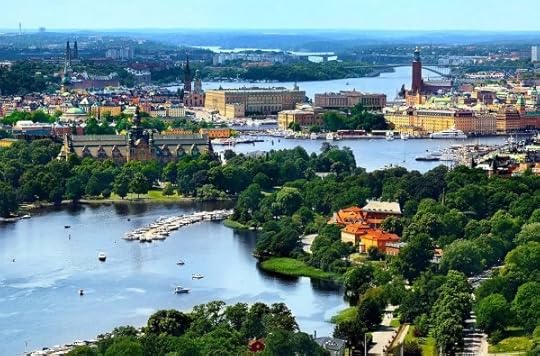
The term Green City can be understood in two ways: GREEN as defined by Spiral Dynamics Integral (SDi) and Green as referenced in the global conversation about sustainability.
GREEN (spelled all in capitals) as used by SDi in the context of this article means a level of complexity for governance that sees the world in terms of plural values, environmental awareness, compassion, acceptance and social equity.
Green (with capital “G” only), according to Wikipedia, relates to sustainable Green Cities. “Sustainable cities which feature urban sustainability… designed with consideration for social, economic, environmental impact, and resilient habitat for existing populations, without compromising the ability of future generations to experience the same. These cities are inhabited by people who are dedicated towards minimization of required inputs of energy, water, food, waste, output of heat, air pollution – CO2, methane, and water pollution.”
Many cities in the world are aspiring to be Green. Chicago might have started the trend by creating a city with the most green roofs—thereby actually accomplishing a drop in the average temperature of the city by removing the heat sink of black, impervious, heat-generating materials on rooftops.
To read the full article click here.
This Manifesto is paired with the Manifesto for New Sincerity by Oleg Lega for a reading/declaration at the Wemakethe.city festival in Amsterdam on June 19, 2019.
June 2, 2019
Comparing Integral City Intelligences with Charles Eisenstein Living Earth
“If you knew she could feel, you would stop,” says Charles Eisenstein about the living Earth.
We met at the Climate Change and Consciousness CCC19 conference at Findhorn Scotland. Charles made it very clear in his plenary keynote, workshop and new book “Climate” that he agreed with James Lovelock that Earth was a living system. As such the planet has organs that keep her in balance from the lungs of the Amazon Forests to the temperature regulator of the Greenland Glaciers.
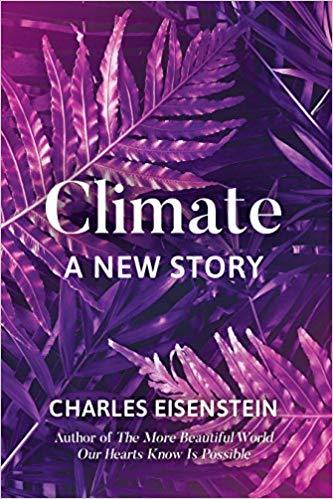
Although Charles seemed reluctant to recognize cities as Gaia’s “reflective organs” (my intuition from Lovelock’s contentions that humans have evolved to add value to the Earth as her “reflective organs”), he agreed that cities were important and would continue – albeit probably in reduced size (and possibley number?).
As I considered the value that cities add to the climate change action equation, I was reminded to return to the 12 Intelligences Discovery Tool, that I had developed to map observations of the city through the lens of the 12 Intelligences.
This is a tool I have used with my clients like Durant, as well as during Beyond Resilient Trainings to map capacities of Trainees and for taking readings of prototype communities like Findhorn.
In fact, I used the CCC19 conference as the context to review the effectiviness of the Integral City 12 Intelligences and assessed how the CCC19 experience demonstrated the value of the set of “rules” that support each intelligence.
The assessments with comments follow.
In summary, I think we could say that the Contexting Intelligences of Ecosphere, Emergence, Integral and Living were not surprisingly demonstrated the highest ratings.
Individual Intelligences and Collective Intelligences varied depending on knowledge, age and willingness to attend to “Inner Climate” along with “Outer Climate”.
The Strategic Intelligences of Inquiry, Meshworking and Navigating were lowest rated – as the inquiry, action and impact that people were seeking were not well aligned or coherent.
Finally the Evolutionary Intelligence had high awareness but only moderate willingness to demonstrate.
The Discovery Assessment presented below can give Cities places, processes and practical directions for action and impact related to Climate Change and Consciousness – and might offer Charles Eisenstein a more detailed lens to consider cities as Gaia’s Reflective Organs.
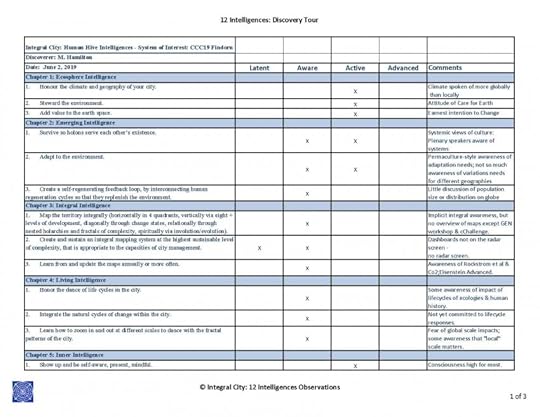
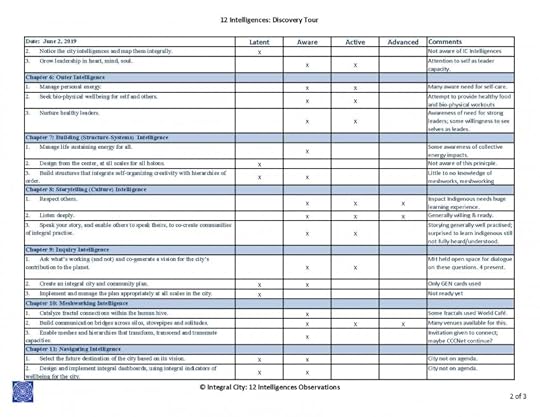

Marilyn Hamilton's Blog
- Marilyn Hamilton's profile
- 3 followers




